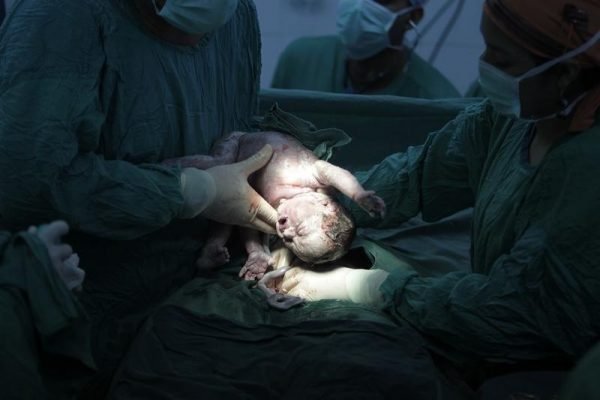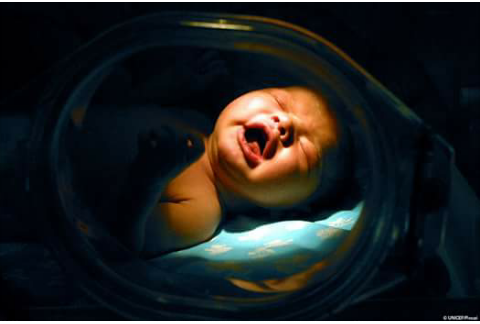
A screaming lady trying to catch her intermittent breathe, a terrified husband holding her hand, a crying mother patting her back, tears falling from people’s eyes all around, and the sound of a baby’s heartbeats could be heard amid doctor’s observations; this is a natural delivery scene that many of us have become accustomed to through television or even experienced in real life. However, it can become a nightmare for Egyptian women, making them resort to a C-section (cesarean) to avoid any such experiences.

Recent studies on cesarean childbirths in Egypt unveiled that the country ranked third in the world, after Brazil and the Dominican Republic, and first in the Middle East, after experiencing an alarming increase of 52 percent in cesarean childbirths.
Despite C-sections being four-times more dangerous than regular deliveries, the study, which was released by the United Nations Population Fund (UNFPA), revealed an increase in the number of cesarean deliveries since 2005 in Egypt, with the most significant increase taking place between 2008 and 2014, remarkably doubling from 26.7 percent to 51.8 percent.
Debate was sparked in the discussion about the reasons behind those startling indices of C-section rates in Egypt. Some studies attributed the increase to be associated with a shift towards delivery in private health-care facilities.
This assumption was backed by the UNFPA study which analyzed 13 governmental hospitals and three privately-owned ones to find that number of C-section surgeries stood at 66 percent in privately-owned hospitals, but only 44 percent in governmental hospitals.
While other studies denied this point, a 2008 survey by the Demographic and Health Survey (DHS) found that nearly one-third of births in public hospitals were delivered by a C-section.
Other researchers attributed the rise to the obstetrician’s greed, as the average cost of a cesarean delivery in Egypt is worth LE1,076, while a natural delivery costs only LE664.
On a separate note, some obstetricians say that a mother’s preference is the biggest reason, especially when mothers are potentially at a low risk for C-section delivery. Others assumed that the lack of medical protocols and required devices for natural labor at hospitals, especially public ones, are the main cause of the increase.
Fear of Natural birth risks
Surprisingly, a study released by the National Institute of Health found that this sizable rise in the proportion of C-sections in the private sector was driven by increasing C-sections among mothers who are theoretically and empirically known to not be at risk of C-sections, including mothers aged between 25–29 years, mothers of a normal body mass index (BMI), and mothers with babies of a normal birth weight, or singleton babies.
Egypt Independent interviewed a number of new mothers and pregnant ladies who had undergone C-section. Most of the answers revealed that their interest in C-section surgery stems from wanting to avoid the pain of labor contraction and keep themselves and their babies safe from some potential risks of natural birth. Only a few mothers voiced regret about their experience.
Having four C-sections increases chances of death during C-sections more than natural vaginal births – a fact some physicians might not recognize, Sameh Sadek, director of the Alexandria Regional Medical Center, told Middle East Eye. Sadek described the increase of C-section surgeries in Egypt as an “endemic problem.”
Nada Akram, a new mother, narrated her C-section experience. “I remember feeling shaky and cold due to anaesthesia. I can recall the incision’s pain very well, it was unbearable, and the worst moment was when the nurse asked me to get up and walk around, suddenly I felt if time stopped for few seconds. The pain was excruciating, I was not able to move my legs.”
Akram said that giving birth through C-section was her obstetrician’s choice. She kept saying that she would prefer to go though natural delivery but her physician refused, due to medical reasons.
“Actually I did not feel my case needed a cesarean, but he insisted,” she said.
Akram voiced her discontent with the experience, saying that if she could turn back time she would stand by her own choice or even change the doctor.
Meanwhile, Nada Mohammed, a journalist who gave birth through C-section 8 months ago, said that she was not convinced enough by the doctor’s decision. “Actually until this moment I don’t know the actual reason,” she said.
Nada’s experience started when her gynaecologist assured her she would give birth naturally, but in her 36th week he said that there is no amniotic fluid around the fetus, and she must deliver as soon as possible through C-section, because the cervix has not opened yet, and if she waited it will endanger the baby. So, she agreed.
“After my delivery, I’ve read several experiences similar to mine, [about women] who gave birth naturally. I don’t have the medical background so I can’t judge the doctor’s intentions, but I can acknowledge that there were some medical complications. But 90% of the doctor’s decision is based on money,” she said.
On the other hand, there were supporters to the C-section from mothers to be.
“I gave birth to my first baby girl through a C-section, and if I will give birth to six babies I will strongly go for C-section. I decided earlier and I genuinely loved the experience, the operation was done under spinal anaesthesia, which was much better to avoid general anaesthesia complications,” Dina Zakaria, a marketing employee, said.
Doctors believe that women whose first labor was cesarean, will most likely give birth to their next babies through C-section. The UNFPA study found that both hospitals and gynaecologists confirmed that 26 percent of women who had undergone C-section to give birth to their first child will be subjected to the same operation in future labor. Meanwhile, 29 percent of doctors believe that the second delivery after a C-section will depend on the individual women’s situation, and 36 percent of them said they will most likely go through a cesarean, while only 7 percent said they would rather give birth naturally, but under observation.
“I think C-section is much better because natural delivery ends up with some complications: for instance, after going through the painful labor contractions for many hours, most doctors will decide to go with a C-section, so you’ll experience both pains,” said Zakaria.
Zakaria believed that doctors have recently resorted to C-section to avoid complications, especially as many pregnant women experience some medical complications during their pregnancies, like an under-weighted fetus, placenta abnormalities, and premature births.
My Refarrel is @sherbanu
Hi! I am a robot. I just upvoted you! I found similar content that readers might be interested in:
http://www.egyptindependent.com/c-section-surgeries-rise-egypt/
Hey @shahriatasfia. As a Greeter for @greetersguild, I am here to help everyone learn, earn and grow. Copying work from another source that is not yours is very frowned upon on Steemit. To avoid getting flagged (downvote) from other members and ending up on a blacklist, please source where your work comes from. Source means to copy the link that you take text or pictures from and paste the link into your post. Please keep this in mind when you write future post and edit this post with the link that @cheetah posted since that is where this came from. We want to see everyone succeed and I am here to help teach others who are new so that they can learn before a bigger Steemian comes in and flags them.
I see why you wanted to talk about this topic, it is a very nice article. Just source your work and try to add your own thought to the article. Thank you and I hope you understand!